OCZ Octane 128GB SSD Review
by Anand Lal Shimpi on December 28, 2011 12:27 AM ESTAnandTech Storage Bench 2011
Last year we introduced our AnandTech Storage Bench, a suite of benchmarks that took traces of real OS/application usage and played them back in a repeatable manner. I assembled the traces myself out of frustration with the majority of what we have today in terms of SSD benchmarks.
Although the AnandTech Storage Bench tests did a good job of characterizing SSD performance, they weren't stressful enough. All of the tests performed less than 10GB of reads/writes and typically involved only 4GB of writes specifically. That's not even enough exceed the spare area on most SSDs. Most canned SSD benchmarks don't even come close to writing a single gigabyte of data, but that doesn't mean that simply writing 4GB is acceptable.
Originally I kept the benchmarks short enough that they wouldn't be a burden to run (~30 minutes) but long enough that they were representative of what a power user might do with their system.
Not too long ago I tweeted that I had created what I referred to as the Mother of All SSD Benchmarks (MOASB). Rather than only writing 4GB of data to the drive, this benchmark writes 106.32GB. It's the load you'd put on a drive after nearly two weeks of constant usage. And it takes a *long* time to run.
1) The MOASB, officially called AnandTech Storage Bench 2011 - Heavy Workload, mainly focuses on the times when your I/O activity is the highest. There is a lot of downloading and application installing that happens during the course of this test. My thinking was that it's during application installs, file copies, downloading and multitasking with all of this that you can really notice performance differences between drives.
2) I tried to cover as many bases as possible with the software I incorporated into this test. There's a lot of photo editing in Photoshop, HTML editing in Dreamweaver, web browsing, game playing/level loading (Starcraft II & WoW are both a part of the test) as well as general use stuff (application installing, virus scanning). I included a large amount of email downloading, document creation and editing as well. To top it all off I even use Visual Studio 2008 to build Chromium during the test.
The test has 2,168,893 read operations and 1,783,447 write operations. The IO breakdown is as follows:
| AnandTech Storage Bench 2011 - Heavy Workload IO Breakdown | ||||
| IO Size | % of Total | |||
| 4KB | 28% | |||
| 16KB | 10% | |||
| 32KB | 10% | |||
| 64KB | 4% | |||
Only 42% of all operations are sequential, the rest range from pseudo to fully random (with most falling in the pseudo-random category). Average queue depth is 4.625 IOs, with 59% of operations taking place in an IO queue of 1.
Many of you have asked for a better way to really characterize performance. Simply looking at IOPS doesn't really say much. As a result I'm going to be presenting Storage Bench 2011 data in a slightly different way. We'll have performance represented as Average MB/s, with higher numbers being better. At the same time I'll be reporting how long the SSD was busy while running this test. These disk busy graphs will show you exactly how much time was shaved off by using a faster drive vs. a slower one during the course of this test. Finally, I will also break out performance into reads, writes and combined. The reason I do this is to help balance out the fact that this test is unusually write intensive, which can often hide the benefits of a drive with good read performance.
There's also a new light workload for 2011. This is a far more reasonable, typical every day use case benchmark. Lots of web browsing, photo editing (but with a greater focus on photo consumption), video playback as well as some application installs and gaming. This test isn't nearly as write intensive as the MOASB but it's still multiple times more write intensive than what we were running last year.
As always I don't believe that these two benchmarks alone are enough to characterize the performance of a drive, but hopefully along with the rest of our tests they will help provide a better idea.
The testbed for Storage Bench 2011 has changed as well. We're now using a Sandy Bridge platform with full 6Gbps support for these tests.
AnandTech Storage Bench 2011 - Heavy Workload
We'll start out by looking at average data rate throughout our new heavy workload test:
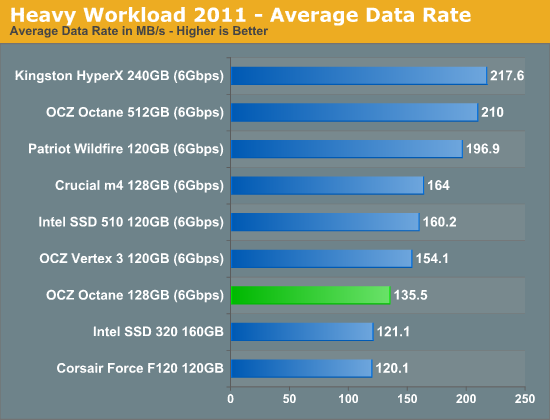
For write-heavy workloads the 128GB Octane is faster than the previous generation 3Gbps drives, but still a bit slower than the 6Gbps Intel, Crucial and SandForce based offerings.
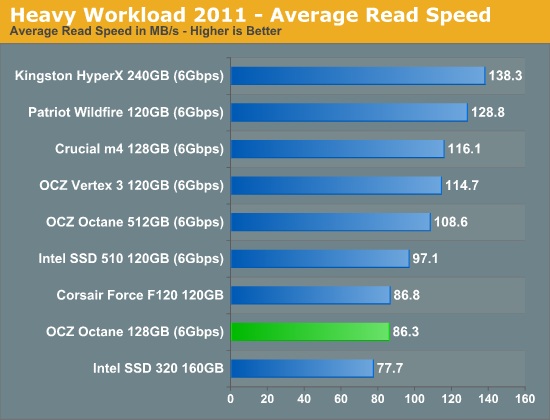

The next three charts just represent the same data, but in a different manner. Instead of looking at average data rate, we're looking at how long the disk was busy for during this entire test. Note that disk busy time excludes any and all idles, this is just how long the SSD was busy doing something:
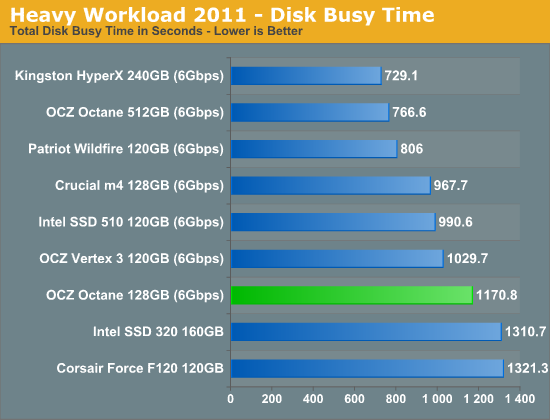
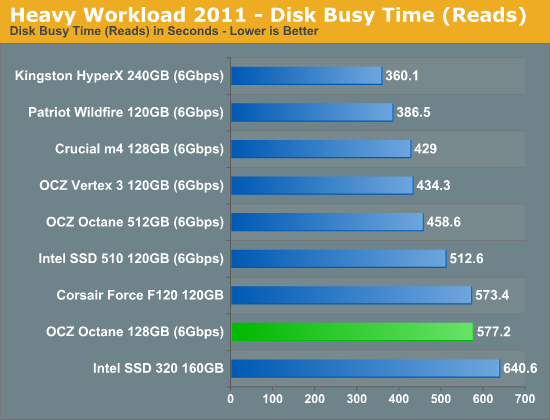
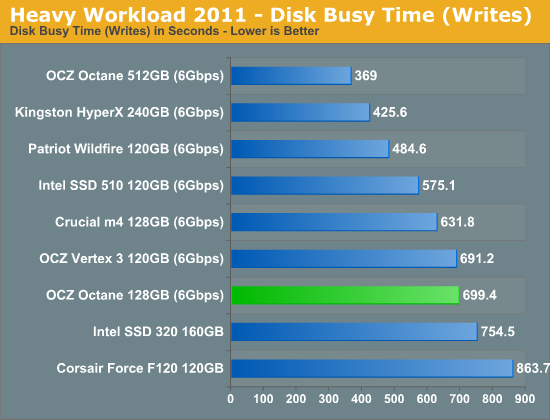










38 Comments
View All Comments
daos - Thursday, December 29, 2011 - link
I recently purchased this drive from the egg and I love it. Very reliable and not one blue screen. This is coming straight from a Sandforce 2281 Corsair Force GT 60GB that would blue screen sitting idle. That drive drove me crazy. Ill never go back to another Sandforce. So far so good. Been running this drive for abourt a month now.gamoniac - Thursday, December 29, 2011 - link
Anand,Last October, you reviewed Kingston's SSDNow V+100 128GB (with Toshiba controller) and gave it a pretty high mark. It performed admirably under both light and heavy Anand Benchmark. A couple months back, the new SSDNow V200 is out, with JMicron controller and better specs than the V+100. I personally own two of each model but the benchmarks I have taken left me puzzled as to what to think about the newcomer. The random read/write department is great but the sequential read/write department is way bad, despite of the 6Gbps specs. I personally thinkg V+100 is way better and feel quite a bit ripped off by V200.
There is no reviews out there for V200 yet and detail info is hard to find. Do you think you can shed some light on the latest from Kingston? Thanks much, and happy new year.
erple2 - Friday, December 30, 2011 - link
Wasn't there a firmware update that was released for the M4's that substantially boosted speeds? I seem to remember that happening after the 256GB drive was released/reviewed.erple2 - Friday, December 30, 2011 - link
Meep. Nevermind. I just re-read the article you linked.johnf1285 - Friday, December 30, 2011 - link
So at what point can we expect to have this SSD turn into a brick just like every other OCZ SSD that I've ever owned?chasM - Sunday, January 1, 2012 - link
Sorry to say it, but all the prices from newegg,amazon, and Compusa are for a different drive. That model is more in the $170 range.LoosCarl - Sunday, January 1, 2012 - link
Get OCZ Octane SSDs from Amazon, if you missed it: http://cl.lk/21hkw07binqq - Friday, January 6, 2012 - link
Our Website: ===== www fashion-long-4biz com ====Our main product list is as follows: